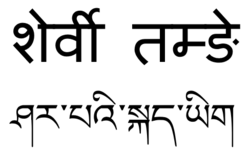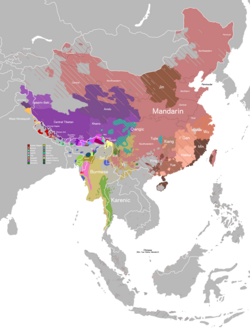lingvo.wikisort.org - Language
Sherpa (also Sharpa, Xiaerba, or Sherwa) is a Tibetic language spoken in Nepal and the Indian state of Sikkim, mainly by the Sherpa. The majority speakers of the Sherpa language live in the Khumbu region of Nepal, spanning from the Chinese (Tibetan) border in the east to the Bhotekosi River in the west.[3] About 200,000 speakers live in Nepal (2001 census), some 20,000 in Sikkim (1997) and some 800 in Tibetan Autonomous Region (1994). Sherpa is a subject-object-verb (SOV) language. Sherpa is predominantly a spoken language, although it is occasionally written using either the Devanagari or Tibetan script.[3]
This article may be expanded with text translated from the corresponding article in Nepali. (August 2018) Click [show] for important translation instructions.
|
| Sherpa | |
|---|---|
| शेर्वी तम्ङे, śērwī tamṅē, ཤར་པའི་སྐད་ཡིག, shar pa'i skad yig | |
 'Sherpa' in Devanagari and Tibetan scripts | |
| Native to | Nepal and India |
| Region | Nepal, Sikkim, Tibet |
| Ethnicity | Sherpa |
Native speakers | 170,000 (2001 & 2011 census)[1] |
Language family | Sino-Tibetan
|
Writing system | Tibetan, Devanagari |
| Official status | |
Official language in | |
| Language codes | |
| ISO 639-3 | xsr |
| Glottolog | sher1255 |
| ELP | Sherpa |
 Sherpa is classified as Vulnerable by the UNESCO Atlas of the World's Languages in Danger | |
Phonology
Sherpa is a tonal language.[4][5] Sherpa has the following consonants:[6]
Consonants
| Labial | Dental | Alveolar | Retroflex | Palato- alveolar |
Palatal | Velar | Glottal | ||
|---|---|---|---|---|---|---|---|---|---|
| Nasal | m ⟨མ m⟩ | n ⟨ན n⟩ | ɲ ⟨ཉ ny⟩ | ŋ ⟨ང ng⟩ | |||||
| Plosive/ Affricate |
voiceless | p ⟨པ p⟩ | t̪ ⟨ཏ t⟩ | t͡s ⟨ཙ ts⟩ | ʈ ⟨ཊ ṭ⟩ | t͡ʃ ⟨ཅ c⟩ | c ⟨ཀྱ ky⟩ | k ⟨ཀ k⟩ | |
| aspirated | pʰ ⟨ཕ ph⟩ | t̪ʰ ⟨ཐ th⟩ | t͡sʰ ⟨ཚ tsh⟩ | ʈʰ ⟨ཋ ṭh⟩ | t͡ʃʰ ⟨ཆ ch⟩ | cʰ ⟨ཁྱ khy⟩ | kʰ ⟨ཁ kh⟩ | ||
| voiced | b ⟨བ b⟩ | d̪ ⟨ད d⟩ | d͡z ⟨ཛ dz⟩ | ɖ ⟨ཌ ḍ⟩ | d͡ʒ ⟨ཇ j⟩ | ɟ ⟨གྱ gy⟩ | ɡ ⟨ག g⟩ | ||
| Fricative | s ⟨ས s⟩ | ʃ ⟨ཤ sh⟩ | h ⟨ཧ h⟩ | ||||||
| Liquid | voiceless | l̪̥ ⟨ལྷ lh⟩ | ɾ̥ ⟨ཧྲ hr⟩ | ||||||
| voiced | l̪ ⟨ལ l⟩ | ɾ ⟨ར r⟩ | |||||||
| Semivowel | w ⟨ཝ w⟩ | j ⟨ཡ y⟩ | |||||||
- Stop sounds /p, t̪, ʈ, k/ can be unreleased [p̚, t̪̚, ʈ̚, k̚] in word-final position.
- Palatal sounds /c cʰ ɟ/ can neutralize to velar sounds [k kʰ ɡ] when preceding /i, e, ɛ/.
- /n/ can become a retroflex nasal [ɳ] when preceding a retroflex stop.
- /p/ can have an allophone of [ɸ] when occurring in fast speech.
Vowels
| Front | Back | |||
|---|---|---|---|---|
| oral | nasal | oral | nasal | |
| High | i | ĩ | u | ũ |
| Mid-high | e | ẽ | o | õ |
| Mid-low | ɛ | ɛ̃ | ɔ | ɔ̃ |
| Low | a | ã | ʌ | ʌ̃ |
- Vowel sounds /i, u/ have the allophones [ɪ, ʊ] when between consonants and in closed syllables.[4]
Tones
There are four distinct tones; high /v́/, falling /v̂/, low /v̀/, rising /v̌/.
Grammar
This section has multiple issues. Please help improve it or discuss these issues on the talk page. (Learn how and when to remove these template messages)
|
Some grammatical aspects of Sherpa are as follows:
- Nouns are defined by morphology when a bare noun occurs in the genitive and this extends to the noun phrase.[incomprehensible] They are defined syntactically by co-occurrence with the locative clitic and by their position in the noun phrase (NP) after demonstratives.
- Demonstratives are defined syntactically by their position first in the NP directly before the noun.
- Quantifiers: Number words occur last in the noun phrase with the exception of the definite article.
- Adjectives occur after the noun in the NP and morphologically only take genitive marking when in construct with a noun.
- Verbs may morphologically be distinguished by differing or suppletive roots for the perfective, imperfective, and imperative. They occur last in a clause before the verbal auxiliaries.
- Verbal auxiliaries occur last in a clause.
- Postpositions occur last in a postpositional NP.
Other typological features of Sherpa include split ergativity based on aspect, SO & OV (SOV), N-A, N-Num, V-Aux, and N-Pos.
Vocabulary
The following table lists the days of the week, which are derived from the Tibetan language ("Pur-gae").
| English | Sherpa |
|---|---|
| Sunday | ŋi`ma ( / ŋ / is the sound Ng') |
| Monday | Dawa |
| Tuesday | Miŋma |
| Wednesday | Lakpa |
| Thursday | Phurba |
| Friday | Pasaŋ |
| Saturday | Pemba |
Sample Text
The following is a sample text in Sherpa of Article 1 of the Universal Declaration of Human Rights:
Sherpa in Devanagari script
- मि रिग ते रि रङ्वाङ् दङ् चिथोङ गि थोप्थङ डडइ थोग् क्येउ यिन्। गङ् ग नम्ज्योद दङ् शेस्रब् ल्हन्क्ये सु ओद्दुब् यिन् चङ् । फर्छुर च्यिग्गि-च्यिग्ल पुन्ग्यि दुशेस् ज्योग्गोग्यि।
Sherpa in Tibetan script
- མི་རིགས་ཏེ་རི་རང་དབང་དང་རྩི་མཐོང་གི་ཐོབ་ཐང་འདྲ་འདྲའི་ཐོག་སྐྱེའུ་ཡིན། གང་ག་རྣམ་དཔྱོད་དང་ཤེས་རབ་ལྷན་སྐྱེས་སུ་འོད་དུབ་ཡིན་ཙང་། ཕར་ཚུར་གཅིག་གིས་གཅིག་ལ་སྤུན་གྱི་འདུ་ཤེས་འཇོག་དགོས་ཀྱི།
Sherpa in the Wylie Transliteration
- mi rigs te ri rang dbang dang rtsi thong gi thob thang 'dra 'dra'i thog skyeu yin/ gang ga rnam dpyod dang shes rab lhan skyes su 'od dub yin tsang/ phar tshur gcig gis gcig la spun gyi 'du shes 'jog dgos kyi/
Translation
- Article 1: All human beings are born free and equal in dignity and rights. They are endowed with reason and conscience and should act towards one another in a spirit of brotherhood.
References
- Sherpa at Ethnologue (18th ed., 2015) (subscription required)
- "50th Report of the Commissioner for Linguistic Minorities in India" (PDF). 16 July 2014. p. 109. Archived from the original (PDF) on 2 January 2018. Retrieved 6 November 2016.
- "Sherpa | History & Culture". Encyclopedia Britannica. Retrieved 28 February 2021.
- Graves, Thomas E. (2007). The Phonetics and Phonology of the Sherpa Language.
- "Sherpa". Ethnologue. Retrieved 30 August 2019.
- "Nepalese Linguistics" (PDF). Journal of the Linguistic Society of Nepal. 23: 371–380. November 2008. Retrieved 8 October 2021.
External links
- Himali Sherpa:Sherpa Culture dictionary
- Sherpa-English and English-Sherpa Dictionary
- Sherpa dictionary Print edition
- Sherpa language Omniglot
На других языках
[de] Sherpa (Sprache)
Sherpa (.mw-parser-output .Tibt.uchen{font-family:"Qomolangma-Dunhuang","Qomolangma-Uchen Sarchen","Qomolangma-Uchen Sarchung","Qomolangma-Uchen Suring","Qomolangma-Uchen Sutung","Qomolangma-Title","Qomolangma-Subtitle","Qomolangma-Woodblock","DDC Uchen","DDC Rinzin","Kailash","BabelStone Tibetan","Jomolhari","TCRC Youtso Unicode","Tibetan Machine Uni","Wangdi29","Noto Sans Tibetan","Microsoft Himalaya"}.mw-parser-output .Tibt.ume{font-family:"Qomolangma-Betsu","Qomolangma-Chuyig","Qomolangma-Drutsa","Qomolangma-Edict","Qomolangma-Tsumachu","Qomolangma-Tsuring","Qomolangma-Tsutong","TibetanSambhotaYigchung","TibetanTsugRing","TibetanYigchung"}.mw-parser-output .Tibt{font-size:140%}ཤེརཔཱ, Devanagari-Schrift .mw-parser-output .Deva{font-size:120%}@media all and (min-width:800px){.mw-parser-output .Deva{font-size:calc(120% - ((100vw - 800px)/80))}}@media all and (min-width:1000px){.mw-parser-output .Deva{font-size:100%}}शेर्पा; auch Sharpa, Sharpa Bhotia, Xiaerba, Serwa) ist eine Sprache, die im Zentral- und Süd-Himalaya – dort in Teilen Nepals und den grenznahen Regionen Chinas und Indiens – vor allem von den Sherpa gesprochen wird. Sie geht auf einen tibetischen Dialekt zurück, der im 15. Jahrhundert in der tibetischen Provinz Kham gesprochen wurde. Von da an hat sie sich für rund 500 Jahre eigenständig entwickelt. In neuerer Zeit steht sie unter äußerem Einfluss des Nepali und der englischen Sprache, von denen sie eine Reihe von Wörtern übernommen hat.[1]- [en] Sherpa language
[fr] Sherpa (langue)
Le sherpa (ཤེརཔཱ , Devnagari: शेर्पा; aussi dénommé sharpa, sharpa bhotia, xiaerba, serwa) est une langue parlée en partie au Népal et au Sikkim principalement par la communauté sherpa. Environ 130 000 locuteurs vivent au Népal (recensement de 2001), environ 20 000 en Inde (1997), et environ 800 au Tibet (1994).[ru] Шерпский язык
Шерпский язык, также шерпа или кангпо[2], — язык шерпов, один из сино-тибетских языков, распространен в Непале (ок. 130 тыс. носителей), а также в индийском штате Сикким.Другой контент может иметь иную лицензию. Перед использованием материалов сайта WikiSort.org внимательно изучите правила лицензирования конкретных элементов наполнения сайта.
WikiSort.org - проект по пересортировке и дополнению контента Википедии
